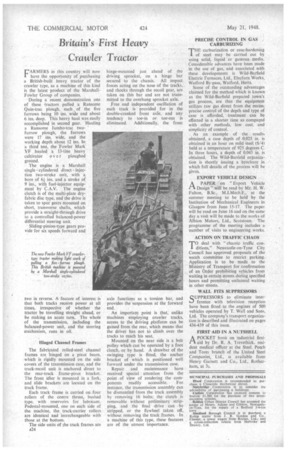Britain's First Heavy
Page 26

If you've noticed an error in this article please click here to report it so we can fix it.
Crawler Tractor FARMERS in this country will now have the opportunity of purchasing a British-built heavy tractor of the crawler type, as a machine of this kind is the latest product of the MarshallFowler Group of companies.
-During a recent demonstration one of these tractors pulled a Ransome• Quin-trac plough, each , of the five furrows being 10 ins, wide and about 6 ins. deep, This heavy haul was easily accomplished in second gear. Hauling Itansorne .Jumbo-trac twofurrow plough, the furrows were 17 ins, wide, and the working depth about 12 ins. In a third test, the Fowler Mark VF hauled a 13-tine heavy cultivator over ploughed. ground.
The . engine is a Marshall single cyl indered direct injection two-stroke unit, with a bore of 6i ins, and a stroke of 9 ins., with fuel-injector equipment by C.A.V. The engine clutch is of the multi-plate dryfabric disc type, and.the drive is taken to spur gears mounted on short, transverse shafts, which provide a straight-through drive to a controlled balanced-power differential steering unit.
Sliding-pinion-type gears provide for six speeds forward and two in reverse. A feature of interest is that both tracks receive power at all times, irrespective of whether the tractor be travelling straight ahead, or be making an acute turn. The whole of the transmission, including the balanced-power unit, and the steering mechanism, runs in oil.
Hinged Channel Frames The fabricated rolled-steel channel frames are hinged on a pivot beam, which is rigidly mounted on the side covers of the transmission case, and the track-recoil unit is anchored direct to the rear-track frame-pivot bracket. The front idler is mounted in a fork, and slide brackets are located on the track frame.
Each track • frame is carried on four rollers of the centre thrust, bushed type, with reservoirs for lubricant. Pedestal-mounted, one on each side of the machine, the track-carrier rollers are identical and interchangeable with those at the bottom.
The side units of the track frames are A24
hinge-mounted just ahead of the driving sprocket, on a hinge bar secured to the chassis. All impact forces acting on the nose of the tracks, and shocks through the recoil gear, are taken on this bar and are not transmitted to the overhung sprocket axle.
Free and independent oscillation of each track is provided for in the double-cranked front axle, and any tendency to • toe-in or toe-out is eliminated. Additionally, the front axle functions as a torsion bar, and provides the suspension at the forward end.
An important point is that, unlike machines employing crawler tracks, access to the driving platform can be gained from the rear, which means that the driver has not to climb over the tracks to reach his seat.
Mounted on the near side is a belt pulley which can be operated by a foot clutch, or by hand. A drawbar of the swinging type is fitted, the anchor bracket of which is positioned well forward under the transmission case.
Repair and maintenance have received special attention from the point of view of rendering the components readily accessible. For instance, the transmission assembly can be dismantled from the track assembly by removing 16 bolts; the clutch is removable without preliminary stripping, and the final drive can be stripped, or the flywheel taken off. without removing the track frames. In a machine of this type, these features are of the utmost importance. PRECISE CONTROL IN GAS CARBURIZING
THE carburization or case-hardening of steel may be carried out by using solid, liquidor gaseous media. Considerable advances have been made in the use of gas, and associated with these developments is Wild-Barfield Electric Furnaces, Ltd., Elecfurn Works, Watford By-pass, Watford, Herts.
Some of the obtstanding advantages claimed for the method which is known as the Wild-Barfield prepared town's gas process, are that the equipment utilizes raw gas direct from the mains; precise control of the depth and type of case is afforded, treatment can be effected in a shorter time as compared with other methods, low cost. and simplicity of control.
As an example of the.. results obtained, a case depth of 0.025 in. is obtained in an hour on mild .steel (S/41 held at a temperature of 925. degrees C In three hours, a depth of 0.043 in. is obtained. The Wild-Barfield organization is shortly issuing a brochure in which full details of the process will be given.
EXPORT VEHICLE DESIGN
APAPER on "Export Vehicle Design" will be read by Mr. H. W. Fulton, B.Sc., M.I.Mech.E., at the summer meeting to be held by the Institution of Mechanical Engineers in Glasgow from June 15-17. The paper will be read on June 16 and on the same day a visit will be made to. the works of Albion Motors, Ltd., Scotstoun. The programme of the meeting includes a number of visits to engineering Works.
ACTION ON TRAFFIC CHAOS
TO deal with "chaotic traffic con, dition.s," Newcastle-on-Tyne City Council has approved proposals of the watch committee to restrict parking. Application is to be made to the Ministry of Transport for .confirmation of an Order prohibiting vehicles from waiting in certain streets during specified hours and permitting unilateral waiting in other streets.
WALL FITS SUPPRESSORS
SUPPRESSORS to eliminate interference with television reception have been fitted to the engines of 500 vehicles operated by T. Wall and Sons, Ltd. The company's transport organization is described and illustrated on pages 436-439 of this issue.
FIRST AID IN A NUTSHELL
.1-1 A POCKET book on industrial first aid by Dr. R. A, Trevethick, resident medical officer at the Steel. Peech and Tozet branch of the United Steel Companies, Ltd., is available from Henry Garnet. and Co., Ltd., Rotherham, at 3;-.












































































